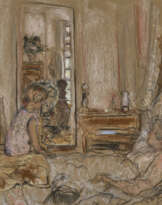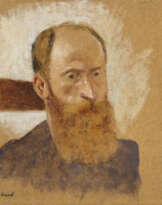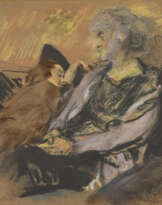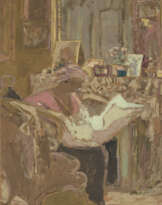ID 1051743
Лот 458 | Édouard Vuillard (1868-1940)
Оценочная стоимость
€ 2 500 – 3 500
Femme assise à la blouse bleue et blanche (pièce du service de table commandé par Jean Schopfer)
avec la marque de la manufacture ‘H&Co. L FRANCE’ (en dessous)
assiette en porcelaine peinte
Diamètre: 24.4 cm.
Exécuté en 1895; cette œuvre est unique
with the manufacture mark 'H&Co. L FRANCE' (underneath)
painted porcelain plate
Diameter: 9 5⁄8 in.
Executed in 1895; this work is unique
Provenance
Jean Schopfer, Paris (acquis auprès de l'artiste, 1895).
Madame Jean Schopfer, Paris (par descendance).
Marcel Kapferer, Paris (acquis auprès de celle-ci en 1935).
Galerie Druet, Paris (probablement en 1938).
Sam Josefowitz, Pully (acquis auprès de celle-ci en 1960).
Puis par descendance aux propriétaires actuels.
Literature
J. Schopfer, ‘Modern Decoration’, in The Architectural Record, janvier-mars 1897, Vol. VI, No. 3, p. 243-255.
N. J. Troy, ‘Towards a Redefinition of tradition on French design’, in Design Issues, automne 1984, Vol. I, No. 2, p. 58 (illustré, fig. 6).
N. J. Troy, Modernism and the Decorative Arts in France, Art Nouveau to Le Corbusier, New Haven, 1991, p. 14, no. 3 (illustré en couleurs).
József Rippl-Rónai's Collected Works, cat. exp, Hungarian National Gallery, Budapest, 1998, p. 476, (illustré fig. 1).
A. Salomon et G. Cogeval, Vuillard, Le Regard innombrable, Catalogue critique des peintures et pastels, Paris, 2003, vol. I, p. 451 (illustré en couleurs,).
A. Leduc-Beaulieu, ‘An Art Nouveau Experiment, Édouard Vuillard's Porcelain Wedding Service for Jean Schopfer, 1895’, in Studies in the Decorative Arts, automne-hiver 2005-2006, Vol. XIII, No. 1, p. 74 (illustré en couleurs, fig. 1).
Exhibited
(probablement) Paris, Galerie Samuel Bing, Salon de l’Art Nouveau, décembre 1895-janvier 1896 (hors catalogue).
Zurich, Kunsthaus et Paris, Galeries nationales du Grand Palais, Nabis, 1888-1900, mai 1993-janvier 1994, p. 397-398, no. 219b (illustré en couleurs, p. 398; image inversée).
Washington, D. C., National Gallery of Art; Montréal, The Montreal Museum of Fine Arts; Paris, Galeries nationales du Grand Palais et Londres, Royal Academy of Art, Édouard Vuillard, janvier 2003-avril 2004, p. 192, no. 132 (illustré en couleurs, p. 193; image inversée).
Further details
Les Nabis ont activement participé au renouveau des arts décoratifs, dans le sillage des Arts and Crafts et sous l’influence de Paul Gauguin qui, lui aussi, avait voulu abolir la distinction hiérarchique entre arts nobles (architecture, peinture, sculpture) et arts appliqués. Comme ses amis Pierre Bonnard, Jozsef Rippl-Ronai ou Ker-Xavier Roussel qui produisent des assiettes à la même époque, Vuillard contribue au même impératif décoratif, en concevant un service de vaisselle en 1895. Son commanditaire, Jean Schopfer, riche mondain élitiste, est proche du cercle de la Revue blanche, par lequel il rencontre Vuillard qui réalisera pour lui deux importantes décorations les années suivantes, Le Jardin du Relais à Villeneuve-sur-Yonne (1898, collection particulière) et La Terrasse à Vasouy (1901, Londres, National Gallery).
Mal cernées pendant longtemps, les circonstances de la commande du service Schopfer ont été désormais éclaircies, grâce aux contributions de Gabriel Weisberg et Gloria Groom et, plus tard, à l’exploitation des documents conservés dans les archives Vuillard. Réalisé entre mai et septembre 1895, on sait par la fille du commanditaire, Leila Mabilleau (L. Mabilleau, Claude Anet, mon père, Paris, 1967, p. 15), que l’ensemble compte 144 pièces au total, non en faïence mais en porcelaine blanche Haviland peinte à la main par l’artiste puis passée au four, et sous la direction technique de Georges Rasetti et non d’André Méthey. Le service a certainement été l’objet d’un cadeau de mariage de Schopfer à son épouse Alice Nye Wetherbee en octobre 1895, un mois après sa livraison et deux mois avant son exposition publique en décembre, dans la galerie de Siegfried Bing, La Maison de l’Art Nouveau.
Schopfer a choisi le modèle de mariage Pompadour chez Haviland, composé de 116 assiettes, de compotiers et de plats. Pour dégager des séquences et une logique d’utilisation, Vuillard a joué de la multiplicité des décors tout en resserrant sa gamme chromatique à trois couleurs (le bleu du cobalt, le vert du cuivre et le brun rouge du fer). Ainsi, comme l’indique Schopfer lui-même dans un article paru deux ans plus tard, « dans les assiettes à poissons domine le vert sur le blanc au fond, et l’assiette est délicatement claire. Dans les assiettes à légumes, le brun et le bleu clair donne la note prédominante, qui, dans les assiettes à viandes, est indiquée par un bleu profond » (J Schopfer, ‘Modern Decoration’, in Architectural Record, janvier-mars 1897, Vol. VI, No. 3, p. 254-255). Des deux assiettes présentées ici, le lot 500 est donc une assiette à viandes et l’autre, le lot 501, à légumes.
Outre la profusion des décors de fond et de bordure, le motif de la femme en buste, décliné en plusieurs modèles, fonde l’unicité du service. Répondant à quelques gabarits qui, chacun, subissent de légères variations, les figures restent uniques et se détachent sur des millefiori, des mouchetis, des vermicules, des lignes ondoyantes, des variations géométriques ou florales, selon un syncrétisme de traditions iconographiques très maîtrisées. De la femme sur fond fleuri, médiévale (La Dame à la licorne que Vuillard admire régulièrement au musée de Cluny), ou italienne (Portrait d’une princesse de la maison d’Este de Pisanello dans les salles du Louvre dès cette époque), l’emprunt s’étend aussi aux estampes japonaises que le peintre collectionne, comme cette courtisane de Kuniyoshi pour ses bleus, ses fleurs et son rythme, ou cet acteur du même artiste, pour l’intrication de son décor sinueux avec des motifs géométriques.
Concomitamment, l’association de la femme et des fleurs, ainsi que la dissolution du sujet dans son fond, trouveront chez Vuillard son dénouement ultime dans l’exécution des Cinq panneaux pour Thadée Natanson, présentés comme une équivalence poétique, en même temps que le service Schopfer à La Maison de l’Art Nouveau en décembre 1895.
Mathias Chivot
Catalogue raisonné d'Édouard Vuillard et Ker-Xavier Roussel
The Nabis movement actively participated in the revival of the decorative arts, following in the footsteps of the Arts and Crafts movement, under the influence of Paul Gauguin. He also sought to remove the hierarchical distinction between the noble arts (architecture, painting, and sculpture), and applied arts. Like his friends Pierre Bonnard, Jozsef Rippl-Ronai, and Ker-Xavier Roussel, who also designed plates at the same time, Vuillard contributed to the same decorative movement by designing a tableware service in 1895. The client, Jean Schopfer, a rich elite socialite, was close to the Revue Blanche circle, through which he met Vuillard, who would create two important pieces for him over the following years, Le Jardin du Relais à Villeneuve-sur-Yonne (1898, private collection) and La Terrasse à Vasouy (1901, London, National Gallery).
The circumstances of the Schopfer service commission have only been recently clarified as a result of Gabriel Weisberg and Gloria Groom contributions, and, later, through documents preserved in the Vuillard archives. Created between May and September 1895, the commissioner’s daughter, Leila Mabilleau (L. Mabilleau, Claude Anet, mon père, Paris, 1967, p. 15), described that the set was comprised of some 144 pieces in total, and was not made of earthenware, but rather from white Haviland porcelain, hand-painted by the artist, and then kiln-fired, under the technical direction of Georges Rasetti, and not of André Méthey. The service was a wedding gift from Schopfer to his wife, Alice Nye Wetherbee, in October 1895, a month after its delivery, and two months before its public display in December, at Siegfried Bing' gallery, La Maison de l’Art Nouveau.
Schopfer chose the Pompadour wedding model from Haviland, consisting of 116 plates, fruit bowls and platters. To bring out sequences and a rationale for their use, Vuillard played with a multiplicity of decorations, whilst constraining his chromatic range to three colours (the blue of cobalt, the green of copper, and the red-brown of iron). Therefore, as Schopfer indicated in an article published two years later, “for the fish plates green dominates over white at the bottom, and the plate is delicately light. For vegetable plates, brown and light blue are the predominant colour tones, and the meat plates are indicated by a deep blue” (J Schopfer, ‘Modern Decoration’, in Architectural Record, vol. VI, No. 3, January-March 1897, p. 254-255). Of the two plates presented here, lot 500 is therefore a meat plate, and the other one, lot 501, is a vegetable plate.
In addition to the profusion of background and border decorations, the motif of the half-length woman, in various versions, brings out the unique character of the service. Using several templates, each with slight variations, the figures become unique because of the millefiori, speckles, vermicules, undulating lines, and geometric and floral variations, with a deft amalgamation of iconographic traditions. From the woman set against a floral background, medieval (La Dame à la Licorne that Vuillard regularly admired at the Musée de Cluny), to Italian (Portrait d’une princesse de la maison d’Este by Pisanello, in the Louvre during that period), this appropriation also extends to Japanese prints, which the painter collected. His courtesan by Kuniyoshi with its blues, its flowers, and its rhythm, or this actor, by the same artist, with the intricacy of its sinuous decoration and geometric motifs are such example.
At the same time, the association of the woman and the flowers, along with the dissolution of the subject into the background, would find its ultimate conclusion by Vuillard in the Cinq panneaux pour Thadée Natanson, presented as a poetic equivalence, simultaneously as the Schopfer service at La Maison de l’Art Nouveau in December 1895.
Mathias Chivot
Catalogue raisonné of Édouard Vuillard and Ker-Xavier Roussel
| Автор: | Эдуар Вюйар (1868 - 1940) |
|---|---|
| Материал: | Керамика |
| Категория аукционного дома: | Все остальные типы объектов |
| Автор: | Эдуар Вюйар (1868 - 1940) |
|---|---|
| Материал: | Керамика |
| Категория аукционного дома: | Все остальные типы объектов |
| Адрес торгов |
CHRISTIE'S 9 Avenue Matignon 75008 Paris Франция | ||||||||||||||
|---|---|---|---|---|---|---|---|---|---|---|---|---|---|---|---|
| Предосмотр |
| ||||||||||||||
| Телефон | +33 (0)1 40 76 85 85 | ||||||||||||||
| Факс | +33 (0)1 40 76 85 86 | ||||||||||||||
| Условия использования | Условия использования | ||||||||||||||
| Транспортировка |
Почтовая служба Курьерская служба Самовывоз | ||||||||||||||
| Способы оплаты |
Банковский перевод | ||||||||||||||
| Часы работы | Часы работы
|













